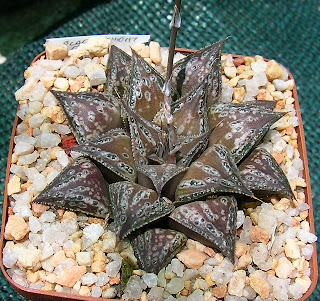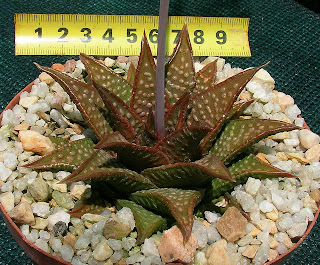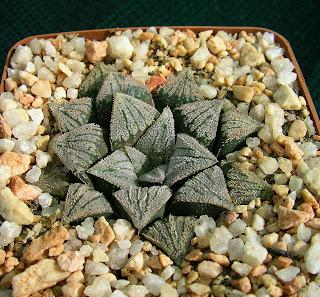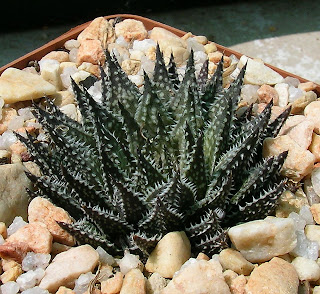고정 헤더 영역
상세 컨텐츠
본문
Marx의 홈페이지에 올라와서 소개하고 있는 아름다운 하월시아 하이브리드 중에서도 글을 올려 따로 좋아하는
아이들로 글을 올린 부분을 발췌해본다. 하이브리드에 대한 영감을 받을 수있는 부분인 것 같다.
(http://www.gerhardmarx.com/ 참조)
A few favorites:
I have to admit that I find some of the most attractive Haworthias in my collection to be hybrids. I think that the field of producing attractive Haworthia cultivars and hybrids has a huge potential and due to the rarity of these plants in the wild it should be encouraged that more collectors should start concentrating on growing and breeding beautiful cultivars instead of only concentrating on purist collections of plants with data.
This short article is meant to share with you a few of the best that I have been able to breed so far.
1. Haworthia cv ‘Lombard Star’
This hybrid is named in honour of George Lombard from Phoenix, Arizona. The reasons for naming it for him are very valid, as he was partly responsible for the creation of this hybrid:
During 1996 George Lombard visited South Africa with the main purpose to see Haworthias in the wild. Both Kobus Venter and I took George on trips to various habitats as we both had known him for a long time via correspondence and valued him as an exceptionally kind and dear friend. We also knew that he was a grower and propagator with exceptional skills.
At the end of the trip I took George to Kobus Venter’s house and we used the opportunity to look at Kobus’s collection. At the time Kobus had just obtained plants of H. mutica from Klippoort, a new locality found by P.V. Bruyns to the south-east of Drew. These plants of H. mutica differed slightly from other forms of H. mutica by having very clear white facial lines as well as a few white ‘dusky dots’ in the windows. Unfortunately only one of the plants were in flower and George and I regretted the fact that we had to wait another year before Kobus may be able to pollinate these plants and share seed with us. But then George noticed that Kobus’s plant of H. mutica ‘White Widow’ was also in flower. The leaf-propagated ‘White Widow’ plant of Kobus was the same clone as the exceptional plant at Karoo Botanic Gardens with large milky clouds in the windows. This plant originated from Sanddrift, which is situated to the north-west of Drew.
George then asked Kobus whether he would mind if we pollinated the Klippoort plant with the flowering ‘White Widow’ from Sanddrift and Kobus agreed and promised to send the seed to us.
George and I went ahead and pollinated the two plants and a few months later Kobus sent the seed to me as promised.
The resulting seedlings yielded many pleasant surprizes. Unlike the ‘White Widow’ that develops the white cloudy windows only gradually during maturity, many of these seedlings showed densely white-flecked windows from an early age already.
A few had almost solid white windows and those I kept for further breeding.
Having a special liking for plants with dense white-flecked windows, I could not wait to cross these white mutica seedlings with other white plants like H. splendens and the very white forms of H. wimii and the Japanese cultivar H. ‘ginsekai’.
The seedlings of the white H. mutica X ‘ginsekai’ turned out very beautiful although they looked rather similar to some white H. wimii cultivars and I then decided that I need to cross it with a longer and larger leaf. H. badia became a very good choice and the seedlings developed into beautiful white compact ‘stars’ with the attractive recurved leaves of H. badia.
H. badia has always been George Lombard’s favourite Haworthia and I then suddenly realized that the most appropriate name for these silver-white stars would be ‘Lombardstar’, particularly because the white H. mutica parents resulted directly from his clever pollination efforts.
|
|
| Haworthia 'Lombard Star'. |
2. Haworthia ‘Black Knight’
In particularly the summer rainfall areas of South Africa it is tricky to get certain summer flowering Haworthias to complete the flowering and fruit development process. Some species like Haworthia marumiana (archeri) and its var. dimorpha, H. wittebergensis, H. maraisii, H. marxii and some members of H. mirabilis have rather thin flower peducles that tend to develop wilting . The peduncle simply gets a soft spot and collapses. At first I thought it to be the result of a fungus due to summer heat and humidity but I am told that it is a tiny insect that stings the peduncle, causing it to collapse.
This happened frequently while I was still living in Grahamstown and it was always a struggle to get flowers and fruit on my summer-flowering Haworthias.
During 1998 all but one of the peduncles on my H. marumiana var dimorpha plants collapsed and I decided to pollinate it with pollen of H. splendens.
The resulting seedlings were quite beautiful and most of them displayed the beautiful dark almost black-green color of dimorpha and with the attractive glossy ‘pimples’ of splendens in the windows. These glossy pimples gave me the impression of scutes or rivets on the black-green armour of a fictional knight and the name ‘Black Knight’ felt quite appropriate.
 |
| Haworthia 'Black Knight' |
3. Haworthia ‘Aluminum Star’
H. badia stands out as one of the Haworthias with the most gracefully recurved leaves which are tightly packed into a neat and compact rosette. This character is a very desireable one to add to the ‘recipe’ of a hybrid, particularly if the other parent is an attractive densely marked H. splendens ( GM 452).
One of the best results I obtained from above pollination is the seedling I named ‘Aluminum Star’ as it has a peculiar metal-like color reminding of aluminium and glossy pimpled surface in combination with the typical recurved leaves of H. badia.
4. Haworthia ‘Chockwonder’
It was George Lombard who gave me a plant of Haworthia ‘Chocolate’ years ago and it does indeed have a very striking dark chocolate colour. It clusters easily and as a result the rosettes stay small. But the unique colour made it a very good potential parent for hybrid production.
I have been using it as parent in many hybrid attempts and several turned out quite good. The best in my opinion was the cross between ‘Chocolate’ and another hybrid which was the result of crossing a very nice white plant of H. wimii ( emelyae var. major) with H. badia. This is the same combination that Bob Kent used to produce his series of ‘Bev’s Wonder’ hybrids. So, one could say that H. ‘Chockwonder’ is a cross between H. ‘Chocolate’ and H. ‘Bev’s Wonder’, although my Bev’s Wonder was a ‘home-made’one by using the same combination of parents. The specific plant that I used has the white and toothed leaves of H. wimii but the longer acuminate leaves of H. badia and does look somewhat similar to Kent’s ‘Bev’s Wonder’ called ‘Imagine”.
H. ‘Chockwonder’ has very attractive irregular chocolate island lines bordering glossy white windows decorated with pimples which almost looks as if H. splendens may have been a parent !
 |
| Haworthia 'Chockwonder' |
5. Haworthia ‘Pink Nebula’
This is the result of crossing a rather red cultivar of GM 447 H. splendens ( given the cultivar name ‘Marx Red’ by Dr Hayashi with the milky white H. mutica from Drew area ( ‘White Widow’ X H. mutica from Klippoort).
‘Pink Nebula’ is very attractive during spring and fall when the pink colour shows up very bright. During mid winter and mid summer the pink colour seem to fade to some extent although it is never completely absent.
It is also a rather large plant and like Aluminum Star it also inherited to some extent the beautiful recurved acuminate leaves of H. badia.
6. Haworthia ‘Someno ‘
H. koelmaniorum (var koelmaniorum) has a long flowering season and flowers prolifically throughout summer. As a result one has many opportunities to cross it with most other members of the Hexangulares and even with most of the Robustipedunculares although the latter efforts seldom produce results.
One successful case was the pollination of a hybrid between the small form of H. marginata and H. minima ( both from Bredasdorp area) with H. koelmaniorum. The H. marginata X minima looks almost identical to H. mortonii.
As young plants these ‘Someno’ hybrids had rather flat open rosettes closer to H. koelmaniorum but as they age they seem to develop more semi-erect leaves and more reminiscent of H. marginata.
The name ‘someno’ is derived from ‘south-meets-north’ and refers to the fact that H. koelmaniorum is one of the northernmost species in South Africa while both the miniature H. marginata and H. minima are found very close to the southernmost tip of the country.
 |
| Haworthia 'Someno' |
7. Haworthia ‘Kent’s Wonder’
I was one of the first people to receive plants of Bob Kent’s well-known and beautiful ‘Bev’s Wonder’ hybrids. In fact, at the time that Bob sent these to me he had not decided on a name yet and was initially considering to call it ‘B-Bev’. only later did he decide upon ‘Bev’s Wonder’ and also devided them into A, B, C, D, etc. clones. By then I already had seedlings of the plants he sent me and therefore I could not quite link my self-produced offspring to his A,B, C,D etc. clones.
‘Kent’s Wonder’ is a hybrid between one of the many ‘Bev’s Wonder’ seedlings I have and a plant that is a cross between the Japanese ‘Ginsekai’ with H. splendens.
 |
| Haworthia 'Kent's Wonder' |
8. Haworthia ‘ Toff-O-Lux ‘
This is a hybrid between a very white plant of H. splendens GM 452 and the Japanese ‘Ginsekai’. It may be a good parent to use for further hybrids as it would be very beautiful if one can get the caramel-brown lines more prominent and bordered by bold cloudy white lines.
It is named after a brand of caramel toffee that is no longer in production as far as I know but which consumed a large portion of my pocket money ( and teeth) as a young child.
 |
| Haworthia 'Toff-O-Lux' |
9. Haworthia ‘Tripple B ‘
This plant is the result of crossing one of my ‘home-made Bev’s Wonder’s’ mentioned above with a cross between H. badia and ‘Ginsekai’. Most of its siblings look almost like pure H. badia for some reason but this one stood out from an early age as it was larger and considerably more rough than the others.
It almost looks as if it has some H. splendens blood and I have wondered wheher I have not made a mistake or a seed from another hybrid batch landed amongst these. Yet, none of the other hybrid batches have quite similar plants although some of the ‘Lombard Star’s look a bit like this although not quite as rough.
Nevertheless, it is quite a nice hybrid and its large size is a very desireable feature.
10. Haworthia ‘Glass Emblem’
Over the years I have selected the most crystalline plants from batches of seedlings of JDV 84-15 H. pygmaea from Great Brak River. The seedlings originally received from Kobus Venter were already nicely ‘crystalline’ but by seed propagation and selection, some results far exceeded the original parents.
By crossing one of the roughest H. pygmaea ‘crystallina’ with a very white plant of H. splendens GM 452 some rather nice seedlings resulted, the best of which was ‘Glass Emblem’. It has the same rough sugar-coated leaf-tops as H. pygmaea ‘crystallina’ but with the glossyness of H. splendens that gives it a glassy transparency.
 |
| Haworthia 'Glass Emblem' |
11. Haworthia ‘Protorose’
This is the result of crossing one of the best H.pygmaea ‘crystallina’ JDV 84-15 with H. ‘Ginsekai’. The plant is small and reminds a bit of H. wimii although the rough texture on the upper leaves is very fine and delicate.
 |
| Haworthia 'Protorose' |
12. Haworthia ‘Gothlet ‘
This dark little rosette covered with white teeth is the result of crossing H.pulchella from Die Draai, north-east of Touwsrivier with H. ‘Bev’s Wonder’. All the seedlings are almost identical and the tray of seedlings looks like a uniform batch of a new species ! The plants are obviously much closer to the H. pulchella mother plant than ‘Bev’s Wonder’.
'하월시아 기르기' 카테고리의 다른 글
| 일본의 하월시아 장인들.. (0) | 2013.08.06 |
|---|---|
| 하월시아 룩우디(Lockwoodii)에 대한 글.. (0) | 2013.08.03 |
| Marx의 하월시아 수정방법 소개.. (0) | 2013.08.02 |
| Marx의 하월시아 Hybrid에 대한 생각읽기.. (0) | 2013.08.02 |
| Gerhard Marx의 홈페이지를 찾아서.. (0) | 2013.08.02 |










댓글 영역